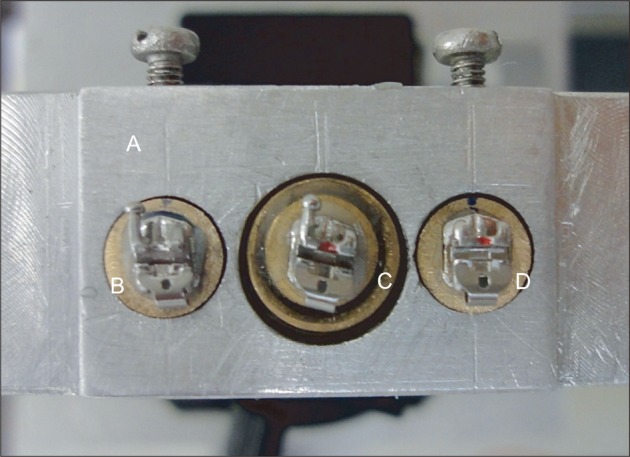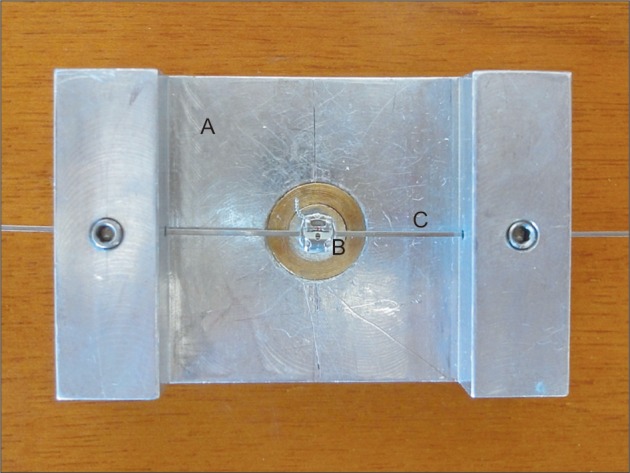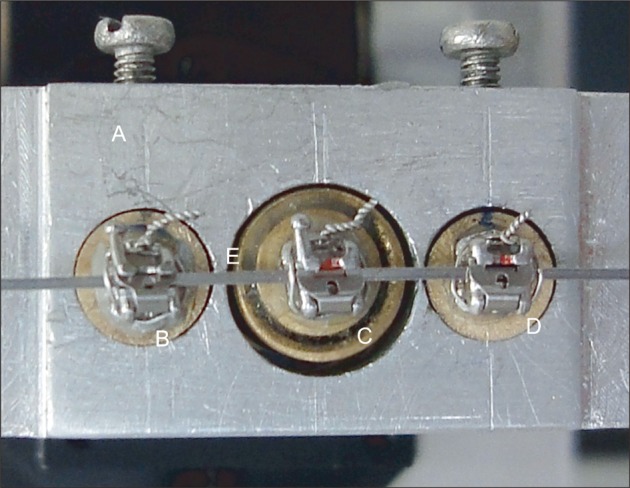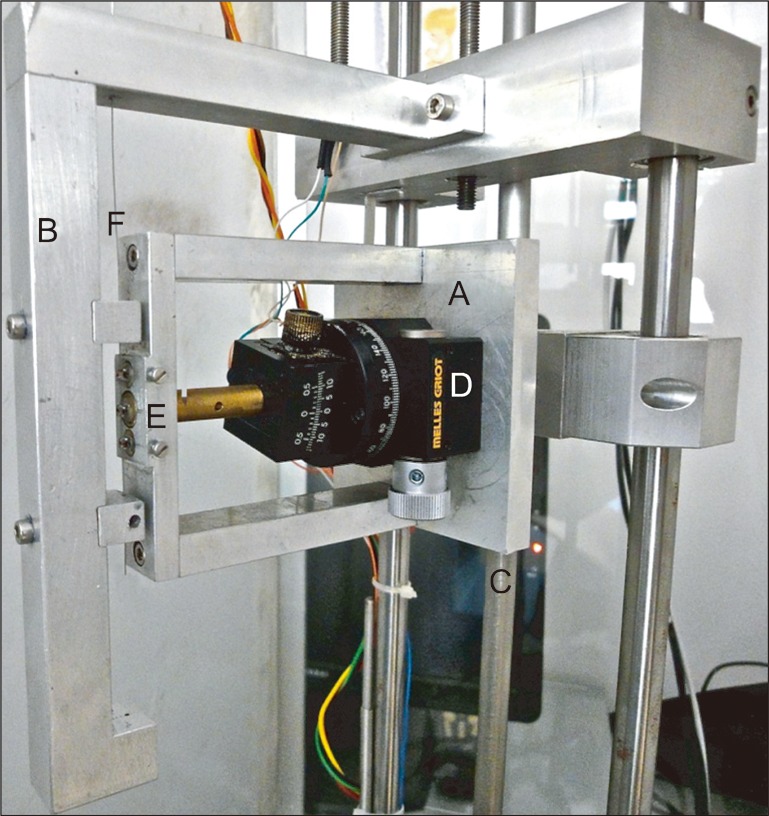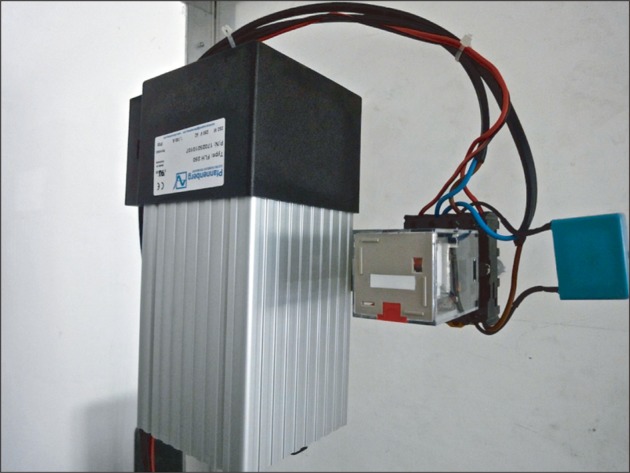Korean J Orthod.
2012 Aug;42(4):218-224. 10.4041/kjod.2012.42.4.218.
In vitro evaluation of resistance to sliding in self-ligating and conventional bracket systems during dental alignment
- Affiliations
-
- 1Department of Orthodontics, School of Dentistry, University of Messina, Messina, Italy. giovannimatarese@virgilio.it
- KMID: 1435416
- DOI: http://doi.org/10.4041/kjod.2012.42.4.218
Abstract
OBJECTIVE
To investigate the resistance to sliding (RS) in self-ligating and conventional ligation bracket systems at 5 different second-order bracket angulations by using low-stiffness alignment wires in a 3-bracket experimental model and to verify the performance of the main RS components in both systems when these wires are used.
METHODS
Interactive self-ligating brackets with closed and open slides were used for the self-ligating (SL) and conventional ligation (CL) groups, respectively; elastomeric ligatures (1 mm inner diameter) were used in the latter system. The alignment wire used was 0.014 inch heat-activated NiTi (austenitic finish temperature set at 36degrees C by the manufacturer). A custom-made testing machine was used to measure frictional resistance. Tests were repeated 5 times at every angulation simulated. All data were analyzed statistically.
RESULTS
The RS increased significantly with increasing angulation in both SL and CL groups (p < 0.0001). However, the RS values were significantly higher at every angulation (p < 0.0001) in the CL group.
CONCLUSIONS
Despite the relevance of the binding phenomenon, ligation forces predominantly affect the RS when low-stiffness alignment wires are used.
Figure
Cited by 1 articles
-
Resistance to sliding in orthodontics: misconception or method error? A systematic review and a proposal of a test protocol
Fabio Savoldi, Aggeliki Papoutsi, Simona Dianiskova, Domenico Dalessandri, Stefano Bonetti, James K. H. Tsoi, Jukka P. Matinlinna, Corrado Paganelli
Korean J Orthod. 2018;48(4):268-280. doi: 10.4041/kjod.2018.48.4.268.
Reference
-
1. Dowling PA, Jones WB, Lagerstrom L, Sandham JA. An investigation into the behavioural characteristics of orthodontic elastomeric modules. Br J Orthod. 1998; 25:197–202. PMID: 9800018.
Article2. Kapila S, Angolkar PV, Duncanson MG Jr, Nanda RS. Evaluation of friction between edgewise stainless steel brackets and orthodontic wires of four alloys. Am J Orthod Dentofacial Orthop. 1990; 98:117–126. PMID: 2378317.
Article3. Voudouris JC, Schismenos C, Lackovic K, Kuftinec MM. Self-ligation esthetic brackets with low frictional resistance. Angle Orthod. 2010; 80:188–194. PMID: 19852660.
Article4. Doshi UH, Bhad-Patil WA. Static frictional force and surface roughness of various bracket and wire combinations. Am J Orthod Dentofacial Orthop. 2011; 139:74–79. PMID: 21195280.
Article5. Thorstenson G, Kusy R. Influence of stainless steel inserts on the resistance to sliding of esthetic brackets with second-order angulation in the dry and wet states. Angle Orthod. 2003; 73:167–175. PMID: 12725373.6. Nishio C, da Motta AF, Elias CN, Mucha JN. In vitro evaluation of frictional forces between archwires and ceramic brackets. Am J Orthod Dentofacial Orthop. 2004; 125:56–64. PMID: 14718880.
Article7. Lucchese A, Carinci F, Brunelli G, Monguzzi R. An in vitro study of resistance to corrosion in brazed and laser-welded orthodontic appliances. Eur J Inflamm. 2011; 9:67–72.8. Hain M, Dhopatkar A, Rock P. The effect of ligation method on friction in sliding mechanics. Am J Orthod Dentofacial Orthop. 2003; 123:416–422. PMID: 12695769.
Article9. Khambay B, Millett D, McHugh S. Archwire seating forces produced by different ligation methods and their effect on frictional resistance. Eur J Orthod. 2005; 27:302–308. PMID: 15947232.
Article10. Chimenti C, Franchi L, Di Giuseppe MG, Lucci M. Friction of orthodontic elastomeric ligatures with different dimensions. Angle Orthod. 2005; 75:421–425. PMID: 15898384.11. Stefanos S, Secchi AG, Coby G, Tanna N, Mante FK. Friction between various self-ligating brackets and archwire couples during sliding mechanics. Am J Orthod Dentofacial Orthop. 2010; 138:463–467. PMID: 20889052.
Article12. Thomas S, Sherriff M, Birnie D. A comparative in vitro study of the frictional characteristics of two types of self-ligating brackets and two types of pre-adjusted edgewise brackets tied with elastomeric ligatures. Eur J Orthod. 1998; 20:589–596. PMID: 9825561.
Article13. Articolo LC, Kusy RP. Influence of angulation on the resistance to sliding in fixed appliances. Am J Orthod Dentofacial Orthop. 1999; 115:39–51. PMID: 9878956.
Article14. Thorstenson GA, Kusy RP. Effect of archwire size and material on the resistance to sliding of self-ligating brackets with second-order angulation in the dry state. Am J Orthod Dentofacial Orthop. 2002; 122:295–305. PMID: 12226612.
Article15. Thorstenson GA, Kusy RP. Comparison of resistance to sliding between different self-ligating brackets with second-order angulation in the dry and saliva states. Am J Orthod Dentofacial Orthop. 2002; 121:472–482. PMID: 12045765.
Article16. Frank CA, Nikolai RJ. A comparative study of frictional resistances between orthodontic bracket and arch wire. Am J Orthod. 1980; 78:593–609. PMID: 6935961.
Article17. Drescher D, Bourauel C, Schumacher HA. Frictional forces between bracket and arch wire. Am J Orthod Dentofacial Orthop. 1989; 96:397–404. PMID: 2816839.
Article18. Kusy RP. Ongoing innovations in biomechanics and materials for the new millennium. Angle Orthod. 2000; 70:366–376. PMID: 11036996.19. Burrow SJ. Friction and resistance to sliding in orthodontics: a critical review. Am J Orthod Dentofacial Orthop. 2009; 135:442–447. PMID: 19361729.
Article20. Pizzoni L, Ravnholt G, Melsen B. Frictional forces related to self-ligating brackets. Eur J Orthod. 1998; 20:283–291. PMID: 9699406.
Article21. Henao SP, Kusy RP. Evaluation of the frictional resistance of conventional and self-ligating bracket designs using standardized archwires and dental typodonts. Angle Orthod. 2004; 74:202–211. PMID: 15132446.22. Henao SP, Kusy RP. Frictional evaluations of dental typodont models using four self-ligating designs and a conventional design. Angle Orthod. 2005; 75:75–85. PMID: 15747819.23. Wilkinson PD, Dysart PS, Hood JA, Herbison GP. Load-deflection characteristics of superelastic nickel-titanium orthodontic wires. Am J Orthod Dentofacial Orthop. 2002; 121:483–495. PMID: 12045766.
Article24. Matarese G, Nucera R, Militi A, Mazza M, Portelli M, Festa F, et al. Evaluation of frictional forces during dental alignment: an experimental model with 3 nonleveled brackets. Am J Orthod Dentofacial Orthop. 2008; 133:708–715. PMID: 18456144.
Article25. Moore RJ, Watts JT, Hood JA, Burritt DJ. Intra-oral temperature variation over 24 hours. Eur J Orthod. 1999; 21:249–261. PMID: 10407534.
Article26. Liaw YC, Su YY, Lai YL, Lee SY. Stiffness and frictional resistance of a superelastic nickel-titanium orthodontic wire with low-stress hysteresis. Am J Orthod Dentofacial Orthop. 2007; 131:578.e12–578.e18. PMID: 17482074.
Article27. Marshall SD, Currier GF, Hatch NE, Huang GJ, Nah HD, Owens SE, et al. Ask us. Self-ligating bracket claims. Am J Orthod Dentofacial Orthop. 2010; 138:128–131. PMID: 20715337.28. Aversa R, Apicella D, Perillo L, Sorrentino R, Zarone F, Ferrari M, et al. Non-linear elastic three-dimensional finite element analysis on the effect of endocrown material rigidity on alveolar bone remodeling process. Dent Mater. 2009; 25:678–690. PMID: 19150574.
Article
- Full Text Links
- Actions
-
Cited
- CITED
-
- Close
- Share
- Similar articles
-
- Effect of different combinations of bracket, archwire and ligature on resistance to sliding and axial rotational control during the first stage of orthodontic treatment: An in-vitro study
- Effect of passive self-ligating bracket placement on the posterior teeth on reduction of frictional force in sliding mechanics
- A comparative study of frictional force in self-ligating brackets according to the bracket-archwire angulation, bracket material, and wire type
- Frictional property comparisons of conventional and self-ligating lingual brackets according to tooth displacement during initial leveling and alignment: an in vitro mechanical study
- Mandibular changes during initial alignment with SmartClip self-ligating and conventional brackets: A single-center prospective randomized controlled clinical trial


